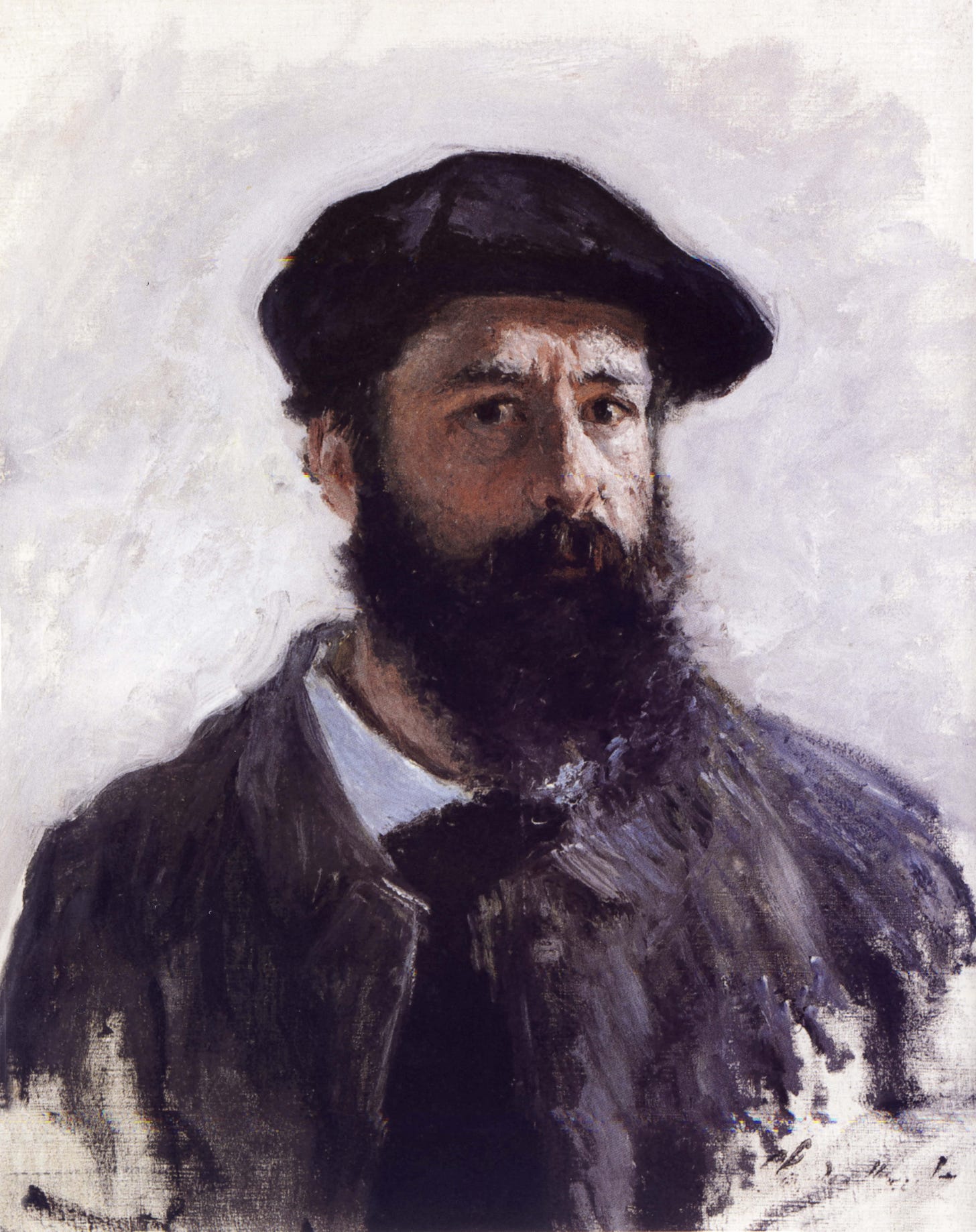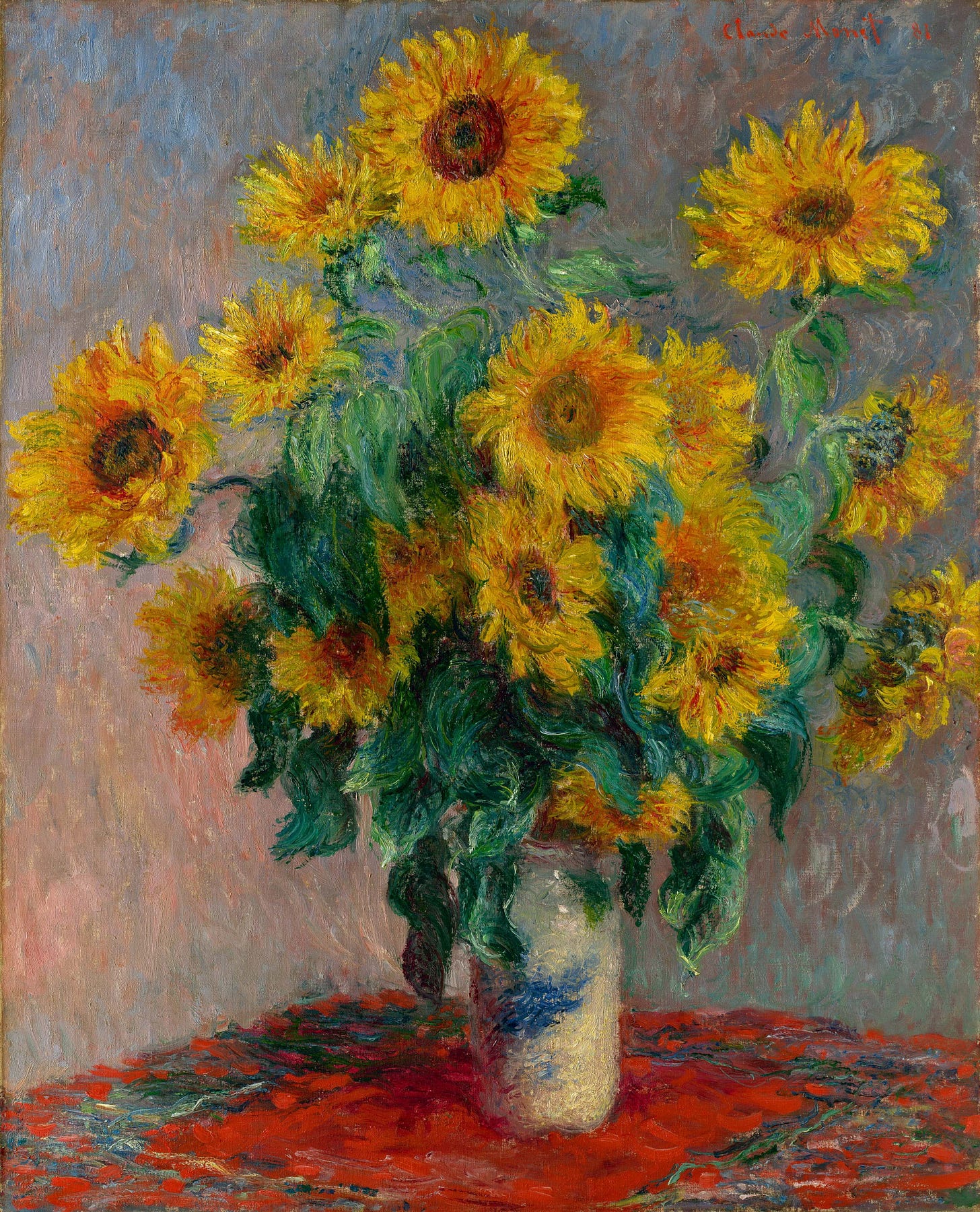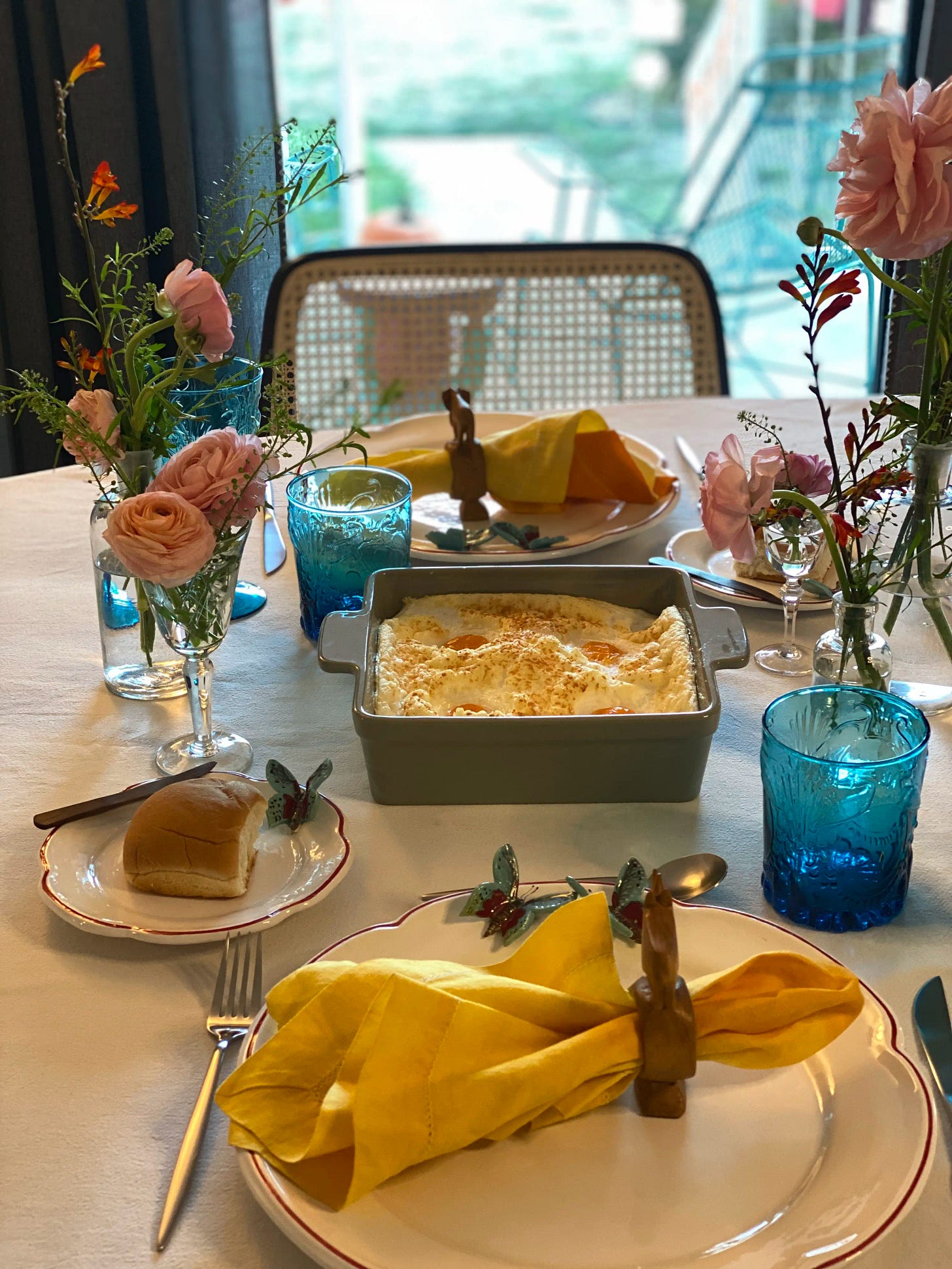Food For Thought
Monet's Palette: The Intersection of Art and Cuisine
It’s easy to think that taste is the only sense tied to food, but the truth is that it’s not that simple. Our senses of sight, smell and sometimes even just hearing the crackle of food frying in a pan all set the stage. The dining experience is layered by a world of details — from the presence of beautiful tablecloths, the volume of background music, the type of cutlery used, to even the people around you. Even memories that are intertwined with certain smells can affect how something tastes. It's emotional. Food is so powerful it has the ability to transport you to another place in your mind.
The act of eating is a complex, sensory experience.
I love cooking, hosting friends, and taking care of plants. One beautiful day, I was gifted a wonderful book that combines all of these passions: Monet’s Table. This book is far more than just a compilation of recipes. When you flip open its pages, you immerse yourself in a world of vibrant colors and impressionism. Monet's beautiful home in Giverny. Monet's fine cuisine. It got me to contemplate on the deeper aspects of life.
Claire Joyes, the author of Monet's table is the wife of Madame Monet’s great-grandson and she has authored numerous books on Claude Monet. In this particular work, she masterfully depicts Monet’s private world.
The Monets’ love for good food is evident in their family meals, festive gatherings, friendly luncheons, and delightful picnics. Just as Monet found inspiration in his beloved gardens and the picturesque Normandy landscape for many of his paintings, the meals served at Giverny were meticulously prepared using outstanding ingredients sourced from the kitchen-garden (a masterpiece in itself), the farmyard, and the French countryside.
Despite being a moody, reserved, and intensely private individual whose daily routine revolved entirely around painting, Monet still took pleasure in hosting his friends — many of whom were prominent figures of the time. Alongside fellow Impressionists such as Renoir, Pissarro, Sisley, Degas, and Cézanne — regular guests included Rodin, Whistler Maupassant Valéry — and one of Monet’s closest companions: statesman Clemenceau. But how could it be any different? Monet valued uncomplicated meals crafted from fresh ingredients and cooked with basic yet genuine techniques, all while being surrounded by beauty in every direction. Of course, we acknowledge that every genius has their own set of challenges and idiosyncrasies. However, who wouldn’t find joy in moments like these? I spend a significant amount of time contemplating the aesthetics of my life. For some inexplicable reason, I have a strong aversion to things that are not visually pleasing. I am the type of person whose productivity and overall well-being is greatly affected if I am not surrounded by an environment that is aesthetically pleasing, whether it be natural or artificial. But is my aversion to the absence of beauty and aesthetics really inexplicable? The renowned English philosopher, Roger Scruton, would argue that my desire to be encompassed by beauty is not inexplicable but also beneficial for one’s well-being.
If you haven’t watched the documentary “Why Beauty Matters” by Roger Scruton or read the book “Everyday Beauty,” I highly recommend that you do so. While you may not necessarily agree with Scruton’s opinions, engaging in the exercise of questioning is both valuable and enjoyable. The central premise of the film is that beauty is not solely a subjective concept but rather a universal human need. Therefore, disregarding beauty also means losing the essence and purpose of life. The documentary begins with Roger Scruton’s powerful statement: “I think we are losing beauty, and with that we are in danger of losing the meaning of life”.
Scruton argued, both in his documentary and in his academic works, that for 2,000 years humans have pursued beauty — in art, architecture, and shaping the human environment in general. Art used to recognize that suffering and chaos are part of human life and offered beauty as a remedy to find joy and meaning in life. In “Monet’s Table,” we are transported to a specific era and particularly to the residence of an individual who placed great emphasis on aesthetics and the impact it had on our lives
“Beauty is not solely a subjective concept but rather a universal human need. Therefore, disregarding beauty also means losing the essence and purpose of life.”
Monet's home at Giverny was a work of art. It was adorned with vibrant wall colors and tile. It was designed for natural light to gentle stream through the windows, and it made the home glisten. Monet personally supervised every detail of the home’s renovation and even handpicked the china. The interior is adorned with blues, bright yellows, and delicate white lace curtains. The kitchen and dining room served as the heart of Monet’s daily life. Disliking the dark and heavy decor that was popular during Victorian times, he opted for a two-tone yellow paint to infuse vibrancy into these spaces. This lively color scheme beautifully complements the blue dishes showcased in the buffets. The walls are adorned with Japanese engravings carefully chosen by Monet himself, showcasing his expert eye for aesthetics.
Monet specifically desired a blue kitchen so that when its door was open, guests would see a harmonious blend of colors with the yellow dining room. The floors feature a striking combination of red and white tiles. The kitchen walls are tastefully covered in Rouen tiles, creating a cool ambiance that contrasts elegantly with the warm glow emanating from Monet’s extensive collection of coppers. Additionally, he personally designed his own Limoges dining pattern which later became one of the most popular china patterns in history.
Monet’s years in Giverny were devoted, passionately, to his art and his love of fine cuisine. His home in Giverny became a mecca for celebrities, politicians, and fellow artists. Guests would enjoy a lunch in the gardens or an intimate meal set in Monet’s beautiful yellow dining room. You would think the conversations that ensued at Monet’s table revolved primarily around art, but it was in fact food that was the usual topic of choice.
“Monet’s table has the sole ambition of serving dishes wonderfully executed with products from the garden or chicken coop” describes the writer at the beginning of the book.
But can you imagine the amount of beauty and how all your senses would be at a lunch in Giverny? Without a doubt, residents and guests ate much more than fine cuisine. The importance of aesthetics lies in its ability to enhance our experiences and enrich our souls. Consider well-designed products or spaces, like Giverny, that are visually pleasing; they not only serve their practical purpose but also bring joy to our lives. Furthermore, aesthetics contributes to our overall well-being by fostering a sense of tranquility and harmony. When we immerse ourselves in beautiful surroundings or listen to melodious music, we experience moments of peace and serenity. These aesthetic experiences have been shown to reduce stress levels and promote mental well-being. So I guess Scruton was right when he said that by losing beauty we are in danger of losing the meaning of life.
Many of the recipes in the book, which were recreated in Monet’s own kitchen by renowned chef Joël Robuchon, feature relatively simple presentation. I mention this because we currently live in a hyper-modernist culture that emphasizes elaborate dish presentation. Please note that I am not criticizing this trend; however, when you evoke your emotional memory of a dish, it is likely that you will recall something more authentic than the visual appeal of a modern restaurant.
It may seem contradictory to discuss the significance of beauty while simultaneously claiming that Monet’s dishes were not visually elaborate. However, it is important to consider that we live in a vastly different era. Nowadays, we often oversimplify our dining experiences while placing excessive emphasis on elaborate dish presentation. We often compromise on ingredient quality in order to save time. The dishes at Giverny were beautiful, but they showcased a distinct form of beauty that contrasts with the sleek modern trends of today. Of course, this is a generalization, but perhaps we can all learn a little from Claude or Roger.
Throughout Monet’s life, his passion for fine cuisine never failed. After he died in 1926, his wife would not allow processed foods into the home and tried to adhere to the example of fine cuisine that Monet had brought to the small village in Normandy.
Monet’s love of art and fine cuisine were intertwined, and both his palate and palette met at his home in Giverny. So, go to the farmers market and get the best and freshest ingredients, get some fresh flowers, set a beautiful table, get a good bottle of wine, grab your best and most beautiful kitchen utensils, pots, pans, and cook like Marguerite — Monet’s cook — and eat like Monet! Eggs Orsini is the recipe I chose from the book to share with you. Make the most of your five senses :)
Recipe for Eggs Orsini:
Ingredients
6 eggs
40 g (3 tbsp) grated cheese
Butter
Salt and freshly ground pepper, to taste
Method
Separate the eggs, keeping the yolks in their shells and removing as much of the whites as possible without breaking the yolks. Tip the whites into a large bowl. Prop up the shells with a scrunched-up dish towel so they remain upright.
Preheat the oven to 180ºC (gas mark 4, or 350ºF).
Season the egg whites with salt, then whisk until they form very stiff peaks (they should be firm enough to withstand the weight of a small spoon without sinking in).
Liberally grease a tray with butter, and pour the egg whites onto it in one fluid motion. Smooth pit with a wooden spoon. Make 6 reasonably deep hollows a good distance apart, and then carefully place an egg in each one. Season with pepper, then sprinkle with grated cheese and butter shavings.
Carefully place at the back of the oven. After about 30 minutes the top should be crispy and golden, and the yolks just set. Serve immediately.
TIP: This simple dish is almost impossible to get wrong, but it cannot be allowed to stand.
This piece is written by Juliana Daidone. Check out her work: julianadaidone.com
This article was originally published in Issue 18 of the WARKITCHEN magazine. You can read it in its original form here. Every member on the list @ warkitchen.net gets first access to every magazine release, right in their email inbox.
Thank you for reading the WARKITCHEN. Till next time 🥂
P.S You can read all of our previous issues @ warkitchen.net/magazines











Rocky, is there any plans on making the War Kitchen a printed magazine in the near future?